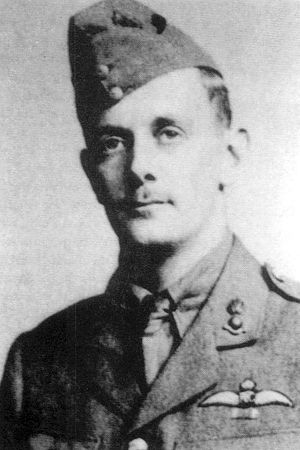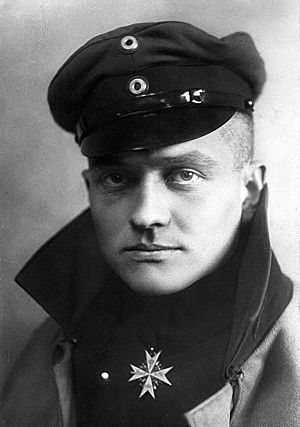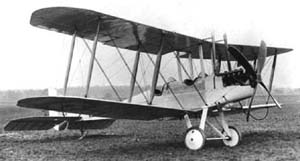Lanoe Hawker facts for kids
Quick facts for kids
Lanoe George Hawker
|
|
|---|---|

Lanoe Hawker c. 1915
|
|
| Born | 30 December 1890 Longparish, Hampshire, England, United Kingdom |
| Died | 23 November 1916 (aged 25) near Bapaume, France |
| Allegiance | United Kingdom |
| Service/ |
British Army |
| Years of service | 1910–1916 |
| Rank | Major |
| Unit | Royal Engineers Royal Flying Corps |
| Commands held | No. 24 Squadron RFC |
| Battles/wars | First World War |
| Awards | Victoria Cross Distinguished Service Order Mentioned in Despatches |
Lanoe George Hawker (born December 30, 1890 – died November 23, 1916) was a very brave British flying ace during the First World War. A flying ace is a pilot who shoots down five or more enemy aircraft. He was one of the first pilots to receive the Victoria Cross, which is the highest award for bravery given to British and Commonwealth soldiers.
Hawker was known for his incredible skill and courage in the air. Sadly, he was killed in a famous air battle, called a dogfight, with the well-known German flying ace, Manfred von Richthofen, often called "The Red Baron." Richthofen himself called Hawker "the British Boelcke," comparing him to a famous German pilot.
Contents
Early Life and Love for Flying
Lanoe Hawker was born in Longparish, England, on December 30, 1890. His family had a long history of serving in the military.
He went to the Royal Navy College when he was 11. However, he often got sick, so a tough naval career wasn't right for him. Instead, he joined the Royal Military Academy, Woolwich to become an officer in the Royal Engineers.
Lanoe was very clever and loved inventing things. He was fascinated by new machines and engineering. In 1910, he saw a film about the Wright Flyer, one of the first airplanes. This sparked his interest in flying. He learned to fly by paying for lessons himself at Hendon. In 1913, he earned his pilot's license.
In August 1914, just before Britain entered the First World War, Hawker joined the Royal Flying Corps. This was the air force of the British Army at the time.
Flying for His Country
In October 1914, Hawker was sent to France as a captain with No. 6 Squadron of the Royal Flying Corps. He flew planes like the Henri Farman and later the B.E.2c. He flew many missions to gather information about enemy positions.
In April 1915, he showed great bravery. He attacked a German zeppelin shed (a place where airships were kept) by dropping hand grenades from his plane at a very low height. He even used a German balloon to hide from enemy fire! For this daring act, he received the Distinguished Service Order award.
During the Second Battle of Ypres, Hawker was shot in the foot. Even though he was hurt, he refused to stop flying until the battle was over. He had to be carried to and from his aircraft.
After recovering, Hawker returned to his squadron. They started getting new single-seat planes called "scouts." Hawker, with help from a mechanic named Ernest Elton, put a Lewis gun on a Bristol Scout C plane. They designed it so the machine gun could fire forward, but at an angle, to avoid hitting the propeller.
Hawker was very creative and came up with many new ideas for the Royal Flying Corps. He helped invent better machine-gun belts and even designed warm, fur-lined boots for pilots to wear at high altitudes to prevent frostbite. These "fug-boots" became standard issue!
Victoria Cross for Bravery
On July 25, 1915, Captain Hawker was flying over Passchendaele. He was flying a Bristol Scout C, which had his special machine gun setup. He bravely attacked three German aircraft one after another.
- He fired all his bullets into the first plane, sending it spinning down.
- The second plane was damaged and forced to land.
- The third plane, a German Albatros C.I, was flying at about 10,000 feet. Hawker attacked it, and it burst into flames and crashed. Both the German pilot and observer were killed.
For this amazing act of courage, Hawker was awarded the Victoria Cross. He was the third pilot ever to receive this award, and the very first fighter pilot to get it. At this time, German planes were starting to get special machine guns that could fire through their propellers. Hawker's plane didn't have this technology, so his gun was mounted to the side, firing at an angle. This meant he had to attack from a specific direction, which made him more exposed to enemy fire. His bravery was even more remarkable because of this.
By late 1915, Hawker had claimed about seven victories. This made him the first British flying ace and a very famous pilot within the Royal Flying Corps.
Leading the First Fighter Squadron
In early 1916, Hawker was promoted to major. He was given command of the Royal Flying Corps' first squadron made up only of single-seat fighter planes, Number 24 Squadron. They flew the Airco DH.2 pusher aircraft. This plane had its propeller at the back, which allowed the machine gun to fire forward easily.
At first, some pilots were worried about the DH.2 because it had a reputation for spinning. To show them it was safe, Hawker flew a DH.2 himself over the squadron base. He put the plane through several spins, recovering safely each time. After landing, he carefully explained to all the pilots how to recover from a spin. This helped the pilots trust the aircraft.
Hawker then led his squadron to France. They helped fight against the German Fokker Eindecker monoplanes, which had been very strong over the Western Front. Hawker had a very aggressive motto: "Attack Everything." This was his only tactical order on June 30, 1916. Because of his leadership, 24 Squadron claimed about 70 victories by November 1916.
Hawker also continued to invent things. He helped develop a better gunsight and a way to hold the Lewis machine gun in place on the DH.2.
Even though Royal Flying Corps rules usually stopped squadron commanders from flying dangerous missions, Hawker often went on patrols and reconnaissance flights, especially over the Somme battlefields.
As 1916 went on, the Germans introduced new, more powerful fighter planes like the Albatros D.I. These new planes made the DH.2 less effective.
Final Battle and Death

On November 23, 1916, Major Hawker was flying his Airco DH.2 plane. He was part of a flight of planes that attacked two German aircraft. Hawker then spotted more German planes and bravely dove to attack them.
He soon found himself in a long and intense dogfight with an Albatros D.II flown by Manfred von Richthofen, "The Red Baron." The Albatros was faster and more powerful than Hawker's DH.2. It also had two machine guns, while Hawker's plane had only one. Richthofen fired 900 rounds during their battle.
Hawker's plane was running low on fuel. He tried to escape and fly back to the Allied lines. Richthofen's guns jammed, but a bullet from his very last burst hit Hawker in the back of the head, killing him instantly. His plane spun down from about 1,000 feet and crashed near Bapaume, France. Hawker became Richthofen's 11th victim.
German soldiers buried Hawker near where his plane crashed. Richthofen took Hawker's Lewis gun from the wreckage as a trophy. Major Lanoe George Hawker is remembered on the Arras Memorial for airmen who were lost and have no known grave.
Legacy
Lanoe Hawker's original Victoria Cross medal was lost during the Second World War. His family's belongings were left behind when France fell in 1940, and the medal was stolen. A new medal was given to Hawker's brother in 1960. Today, it is kept at the Royal Air Force Museum in Hendon.
A special window was made to remember Hawker in St Nicholas church in Longparish in 1967. It shows St Michael above an airfield with two pilots. A copy of this window is also at the Army Flying Museum at Middle Wallop.
Hawker has been shown in movies about World War I pilots. He was played by Corin Redgrave in the 1971 film Von Richthofen and Brown and by Richard Krajčo in the 2008 film The Red Baron.
|




